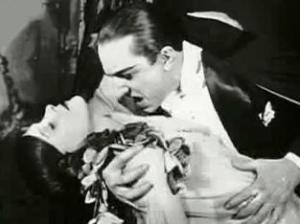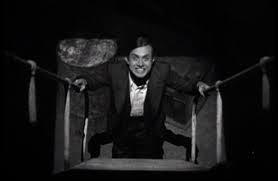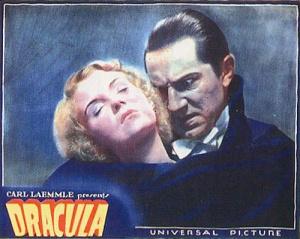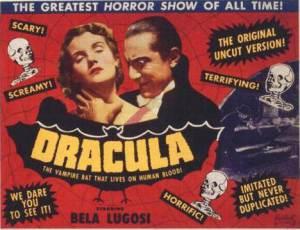As we covered in the previous chapter of this series, Universal Studios now owned the rights to Dracula and they were itching to put their horror star, Lon Chaney into the film. The studio had been founded by the Laemmle family, who had immigrated to the United States from Germany. At the beginning of the era of talkies, family patriarch Carl Laemmle ceded power to his son who had grown up on the scary stories his father had told him as well as the ones in gothic literature. Despite his father’s reluctance, Carl Laemmle Jr. sought to bring those kinds of story to life in the form of cinema. At the time Chaney was synonymous with horror thanks to his ability to create grotesque and troubled characters out of his make-up kit. The studio had recruited director Tod Browning who had formed a bond with the actor working on such films as; The Unknown, London After Midnight, and The Unholy Three. But as fate would have it, Chaney passed away leaving a world of mourning fans behind. Many miles away from Hollywood a Hungarian born actor was bringing Dracula to life on the stage, a man who would become forever connected with the Dracula mythos, Bela Lugosi.
and troubled characters out of his make-up kit. The studio had recruited director Tod Browning who had formed a bond with the actor working on such films as; The Unknown, London After Midnight, and The Unholy Three. But as fate would have it, Chaney passed away leaving a world of mourning fans behind. Many miles away from Hollywood a Hungarian born actor was bringing Dracula to life on the stage, a man who would become forever connected with the Dracula mythos, Bela Lugosi.
In his native Hungary, Lugosi was one of the most revered actors of his generation. He gave critically acclaimed performances in a variety of roles from Hamlet to Jesus Christ. After the chaos of the Hungarian Revolution, the actor immigrated to the United States, and as the the legend has it, he had no money and did not know a single word of English. The foreign mystique he held ended up aiding his career in the United States originally as it was a key factor in his success as Dracula in John Balderston and Hamilton Deane’s Broadway production. But it was not simply his heritage which made him an ideal vampire, Lugosi was incredibly charismatic and carried an aura of mystery with him. He also brought a grand sense of theatricality to the role as every line and gesture he delivered was done at the grandest level possible. Eschewing the decrepit monster of Bram Stoker’s original tale, Lugosi was a much sexier creature of the night, draped in fine evening wear and seducing his victims. Despite the glamour he brought to the character, his Dracula was a monster who knew he was at the top of food chain and had no problem leaving a trail of bodies in his wake. Modern audiences may be accustomed to the infamous Count being a more romantic character, even to the point of falling in love with Mina Harker, but the vampire Bela Lugosi played used romance simply as a ploy to attract victims.
Upon the untimely passing of Lon Chaney Sr., Bela Lugosi saw an opportunity to expand his career and lobbied heavily to bring his blood drinking monster to the big screen. Despite the success he had on Broadway, the studio was uncomfortable resting the film on an actor who had never held a film role. But working in his favor was the advent of talkies, as traditional filmmakers and movie actors were still getting used to this new technique, Hollywood found itself relying on stage actors and directors who had a great deal of experience with dialog. Wisdom at the studio prevailed and Bela Lugosi was brought in to wear the black cape on the silver screen. In addition to Bela Lugosi, Universal studios also brought Edward Van Sloan, to reprise his role as the heroic arch nemesis to Dracula, Dr. Abraham Van Helsing. Much like Lugosi with Dracula, Van Sloan as the intelligent vampire slayer, would go on to originate a role which would become iconic in film history. Also joining the cast were David Manners as the dashing John Harker and Helen Chandler as Mina, the object of Dracula’s fascination. Sadly legendary actress Bette Davis was passed over for the part of Mina, due to Carl Laemmle Sr.’s disapproval of her level of sex appeal. It must be noted that they did not bring the same work ethic to their roles as did their Hungarian co-star. In fact it was reported that they would often mock Lugosi behind his back as the performer paraded in front of a mirror in full costume in order to get into character.

As any horror fan worth his weight in Type O will tell you, Bela Lugosi was not the only actor to deliver a memorable performance in Dracula. Another veteran of the American stage was recruited to play the vampire’s rodent eating emissary, Dwight Frye as the demented Renfield. Straying from (I always thought this to be a logical move personally) it was Renfield, who made the fateful voyage to Dracula’s Castle at the beginning of the story. In return for his helping the Count purchase property in a foreign nation, Renfield was driven insane and used as a slave by the vampire. To this day Dwight Frye is highly regarded as one of the finest stage actors of all time. This was due in part for his ability to turn any character he played into an enthralling performance with his grandiose work. The charismatic character actor had the ability to steal any scene he was in which made for a thrilling experience whenever he acted alongside Lugosi’s Dracula.

Tod Browning remained to direct, Dracula but according to those who worked on the film, the loss of Chaney made him lazy and apathetic while on set. Thankfully legendary cinematographer, Karl Freund was on hand. Freund had worked with some of the greatest filmmakers of all time in his native Germany including, Fritz Lang and Nosferatu’s director, FW Murnau, needless to say he picked up a few tricks he could employ. According to those on set it was his idea to shine lights onto Bela Lugosi’s eyes, to maximize the effect of his hypnotic stare, thus creating one of the most iconic images in film history. As an early talkie the movie was by no means sound on a technical level, but the performances of Bela Lugosi and Dwight Frye made Dracula’s official debut on the silver screen a memorable piece of film history. True the original plan was to film a grand epic version of the novel, but with the Great Depression in full swing, money was tight and a cheaper adaptation was made of the Broadway play.
In Febuary of 1931, audiences were finally treated to the first official adaptation of Dracula. The flick began with a bit of showmanship as Edward Van Sloan delivered a prologue warning audiences of the impending terror they were about to behold. This was a film unlike anything else they had seen before, there had been horror films before, but unlike those this picture had an actual monster. Filmgoers were shocked when they beheld the gothic castle where Dracula resided, infested with bugs and armadillos (due to an archaic set of rules these animals were as about as creepy and crawly as were allowed). The tale as any film fan surely knows, followed the undead villain as he left his native Transylvania and went to the shores of England for fresh prey. In the climax Dr. Van Helsing had to drive a stake through the heart of Dracula, which was done off screen as to not offend the squeamish audiences of the era. In fact due to the moral code films were forced to follow at the time many hallmarks of future vampire films are notably absent such as; bite marks, vampire fangs, and blood.

To this day it is revered for its gothic and melodramatic aspects and holds a special place in the hearts of horror fans for being the first film from Hollywood to utilize a supernatural element. The film was so successful upon it’s release that it led to Universal following it up with another adaptation of Gothic Victorian literature with Frankenstein. In turn these two films released in 1931 were the beginnings of the Universal Monsters franchise which would leave an indelible mark on film history.
While Dracula was being produced, Universal decided to experiment with producing films for potential audiences in Mexico, with the art of subtitles still in its infancy they decided to produce a second version of the film featuring Spanish performers. Once the English speaking crews finished work during the day, the alternate team took over at night. While waiting to use the sets, this production crew watched intently what Browning and Freund were doing and, under the guidance of director George Melford, decided to top it. From a technical stand point the Spanish-language version of Dracula was a smoother and more artistically effective production. It was hindered however by a Count Dracula who paled in comparison to Bela Lugosi. Carlos Villarias desperately tried to bring the same theatricality and mystique to the role as his English counterpart but only succeeded in being laughably over-the-top.
With Dracula leading the way, Universal built an entire franchise on the backs of their monsters. More films featuring these outcast creatures were to follow, which means the Count would continue to haunt the screen.

